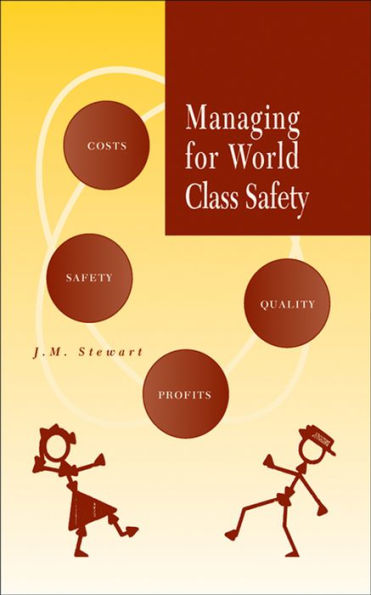| Foreword | ix |
| Preface | xi |
| Acknowledgments | xv |
| 1. | Introduction | 1 |
| 2. | The Model of Safety Management | 6 |
| 2.1 | The Framework of the Model | 6 |
| 2.2 | Designing the Model for Measurement | 9 |
| 2.3 | The Beliefs and Practices for Excellence in Safety | 12 |
| 2.4 | The Cost-Benefit Trade-Off | 17 |
| 2.5 | Limitations of the Model | 24 |
| 3. | The Safety Questionnaire | 27 |
| 3.1 | Backgroup to the Development of the Questionnaire | 27 |
| 3.2 | Scope of the Questionnaire | 30 |
| 4. | Selection of Companies for Research | 33 |
| 4.1 | Size of Company | 35 |
| 4.2 | Difficulties in Identifying Companies with Excellent Safety | 36 |
| 4.3 | Canadian Companies | 37 |
| 4.4 | US Companies | 38 |
| 4.5 | Offshore Companies | 38 |
| 4.6 | Companies with Very Poor Safety | 39 |
| 4.7 | Company Environment-Culture | 40 |
| 5. | Research Methodology | 41 |
| 5.1 | Outline of Research | 41 |
| 5.2 | Collection of Company Data--Very Safe Companies | 44 |
| 5.3 | Questionnaire Survey Procedures | 47 |
| 5.4 | Interviews and Focus Groups | 54 |
| 5.5 | Summary of Companies and Research Undertaken | 57 |
| 6. | Analysis of the Questionnaire Results | 59 |
| Questions 1 and 2 | The Priority Given to Safety | 62 |
| Question 3 | The Belief That All Injuries Can Be Prevented | 69 |
| Questions 4 and 5 | The Interaction Between Business and Safety | 73 |
| Question 6 | The Extent to which Safety Is Built In | 79 |
| Question 7 | The Presence and Influence of Safety Values | 81 |
| Question 8 | Line Management Responsibility--Accountability for Safety | 85 |
| Questions 9 and 10 | Involvement in Safety Activities and Empowerment | 89 |
| Question 11 | Safety Training | 96 |
| Question 12 | The Frequency and Quality of Safety Meetings | 98 |
| Question 13 | Safety Rules | 102 |
| Question 14 | Enforcement of Safety Rules | 105 |
| Question 15 | Injury and Incident Investigation | 107 |
| Question 16 | Workplace Audits/Inspections | 110 |
| Question 17 | Modified Duty and Return-to-Work Systems | 114 |
| Question 18 | Off-the-Job Safety | 117 |
| Question 19 | Recognition for Safety Performance | 119 |
| Question 20 | Employing the Best Safety Technology | 120 |
| Question 21 | Measuring and Benchmarking Safety Performance | 122 |
| Question 22 | The Safety Organization | 124 |
| Question 23 | The Safety Department--Safety Specialists | 126 |
| Question 24 | Satisfaction with the Safety Performance of the Organization | 127 |
| Beliefs and Practices for Which No Questions Were Developed | 129 |
| 7. | The Safety Management Approaches of Five Very Safe Companies | 131 |
| 7.1 | Abitibi-Consolidated, Fort Frances Mill: Safety Excellence in Pulp and Paper Production | 132 |
| 7.2 | DuPont Canada: One of the World's Safest Companies | 142 |
| 7.3 | Milliken and Company: World Class Safety in the Textile Industry | 152 |
| 7.4 | S&C Electric Canada: A Turnaround to Safety Excellence in the Electrical Equipment Industry | 163 |
| 7.5 | Shell Canada: World Class Safety in the Oil Industry | 173 |
| 8. | Conclusions--How Companies Achieve Excellence in Safety | 183 |
| The Commitment of Management to Excellence in Safety | 183 |
| Line Management Ownership of the Safety Agenda | 185 |
| Involvement in Safety Activities, Training, and Empowerment | 186 |
| Comprehensive Safety Practices | 186 |
| Safety Organization and Safety Specialists | 187 |
| Satisfaction with Safety Performance | 187 |
| Validity of the Model and the Questionnaire | 188 |
| 9. | Applying the Results of the Research | 189 |
| Application of the Safety Survey | 190 |
| Combining the Safety Survey with Future State Visioning--The Future State Visioning Workshop | 194 |
| Action from the Survey and Workshop Results | 197 |
| Where the Safety Improvement Process has been Used | 197 |
| Future Use of the Safety Improvement Process | 198 |
| Appendices | |
| A | References and End-Notes | 199 |
| B | Nomenclature | 202 |
| C | Questions for Interviews of Company Leaders | 204 |
| D | Statistical Analysis of Data | 210 |
| E | The Safety Questionnaire | 213 |
| F | Tables of Detailed Results | 230 |
| G | About the Author | 263 |
| Index | 265 |



